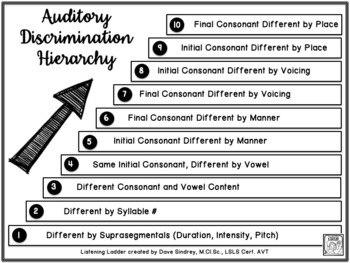
The beneficial effects of across-trial variation during training pose challenges to existing models of perceptual learning. These observations echo earlier reports of speech learning that high-variability training (e.g., speech utterances produced by multiple compared to a single talker) facilitates transfer to untrained materials. Temporal-interval discrimination training, which does not benefit FD performance when conducted alone, does so when mixed with FD training.
#Auditory discrimination skills trial
For example, tone frequency discrimination (FD) learning takes longer, but is more transferable when the standard frequency is randomized among five values (roved) from trial to trial than when it is fixed. However, beneficial effects of across-trial variation of training materials in terms of learning transferability have also been found. Varying the task or the standard value across trials has been reported to disrupt learning. discriminating tone frequencies from a standard of 1 kHz).

In such cases, all training trials are identical except for small variations in the task-relevant stimulus dimension, along which participants are asked to make discrimination or identification judgments (e.g. Conventionally, perceptual learning has been experimentally induced via repetitive training on a single task performed using a single standard stimulus.
#Auditory discrimination skills series
A series of studies has suggested that learning specificity can be influenced by the variability of training materials. The specificity of learning is not only a practical concern, as it heavily limits the benefits of perceptual training, but also a theoretical one, as it has been used to infer the stage of neural processing where learning occurs or the information-weighting strategies learned at the decision-making level. Perceptual learning, the improvement of perception with experience, is typically specific to the trained task and stimuli and rarely transfers to untrained ones. The results provide empirical evidence as well as a theoretic framework for interactions between cognitive and sensory plasticity during perceptual experience.

Third, while WM training transferred broadly to other WM and auditory discrimination tasks, variable-frequency training on duration discrimination did not improve WM, indicating that stimulus variation challenges and trains WM only if the task demands stimulus updating in the varied dimension.

The transfer of learning in both directions was correlated with a reduction of the influence of stimulus variation in the discrimination task, linking WM and its improvement to across-trial stimulus interaction in auditory discrimination. Second, training frequency discrimination around a variable frequency transferred to and from WM learning, but training around a fixed frequency did not. First, the ability to discriminate small differences in tone frequency or duration was correlated with WM measured with a tone n-back task. Here we present three lines of evidence from healthy adults in support of the idea that the enhanced transfer of auditory discrimination learning is mediated by working memory (WM). However, this assumption is incompatible with recent demonstrations that transfer of learning can be enhanced by across-trial variation of training stimuli or task.

Perceptual training is generally assumed to improve perception by modifying the encoding or decoding of sensory information.


 0 kommentar(er)
0 kommentar(er)
